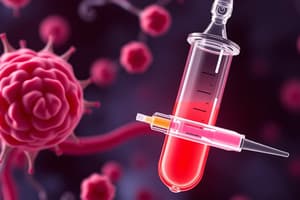Podcast
Questions and Answers
What is the name of the glucose transporter that is recruited to the cell surface in skeletal muscle and fat cells in response to insulin?
What is the name of the glucose transporter that is recruited to the cell surface in skeletal muscle and fat cells in response to insulin?
GLUT 4
Explain the role of insulin in preventing glucose from leaving cells after it enters.
Explain the role of insulin in preventing glucose from leaving cells after it enters.
Insulin promotes the rapid phosphorylation of glucose to glucose-6-phosphate once it enters the cell. This phosphorylation prevents the glucose from being transported back out of the cell via the GLUT transporter.
Describe the two main problems that arise from insulin deficiency, and how they affect glucose levels in the body.
Describe the two main problems that arise from insulin deficiency, and how they affect glucose levels in the body.
Insulin deficiency leads to reduced glucose uptake into tissues, causing energy starvation, and increased glucose release from the liver, leading to hyperglycemia. The combined effect is too little glucose inside cells and too much glucose in the blood.
What is the normal range of plasma glucose levels in mmol/L and mg/dL?
What is the normal range of plasma glucose levels in mmol/L and mg/dL?
What is the primary stimulus for glucagon secretion?
What is the primary stimulus for glucagon secretion?
What is the main target tissue for glucagon, and what effect does glucagon have on this tissue?
What is the main target tissue for glucagon, and what effect does glucagon have on this tissue?
Describe two other hormones that act synergistically with glucagon to raise blood glucose levels.
Describe two other hormones that act synergistically with glucagon to raise blood glucose levels.
How does the endocrine pancreas contribute to fuel homeostasis in the fed and fasted states?
How does the endocrine pancreas contribute to fuel homeostasis in the fed and fasted states?
Explain the primary function of insulin in regulating blood glucose levels.
Explain the primary function of insulin in regulating blood glucose levels.
What are the two phases of insulin secretion and what is responsible for each?
What are the two phases of insulin secretion and what is responsible for each?
Name three major target organs for insulin and briefly describe its effect on each.
Name three major target organs for insulin and briefly describe its effect on each.
Describe the mechanism by which insulin secretion is initiated by glucose.
Describe the mechanism by which insulin secretion is initiated by glucose.
Besides glucose, what other factors can stimulate insulin secretion?
Besides glucose, what other factors can stimulate insulin secretion?
What is the role of somatostatin in the context of insulin and glucagon secretion?
What is the role of somatostatin in the context of insulin and glucagon secretion?
What are the four distinct cell types found within the pancreatic islets, and what hormone does each secrete?
What are the four distinct cell types found within the pancreatic islets, and what hormone does each secrete?
Explain the difference between the first and second phases of insulin secretion in terms of the source of insulin.
Explain the difference between the first and second phases of insulin secretion in terms of the source of insulin.
Flashcards
Insulin
Insulin
A hormone that regulates blood glucose levels by facilitating its uptake into cells.
Glucagon
Glucagon
A hormone that raises blood glucose levels by promoting glucose release from the liver.
Beta cells
Beta cells
Cells in the pancreas that produce and secrete insulin.
Alpha cells
Alpha cells
Signup and view all the flashcards
Glycogen
Glycogen
Signup and view all the flashcards
Glucose Stimulated Insulin Secretion (GSIS)
Glucose Stimulated Insulin Secretion (GSIS)
Signup and view all the flashcards
Target organs of insulin
Target organs of insulin
Signup and view all the flashcards
Insulin secretion regulation
Insulin secretion regulation
Signup and view all the flashcards
Glucose transporter (GLUT)
Glucose transporter (GLUT)
Signup and view all the flashcards
GLUT 4
GLUT 4
Signup and view all the flashcards
Insulin action on glucose
Insulin action on glucose
Signup and view all the flashcards
Insulin deficiency effects
Insulin deficiency effects
Signup and view all the flashcards
Glucagon mechanism
Glucagon mechanism
Signup and view all the flashcards
Insulin and glucagon balance
Insulin and glucagon balance
Signup and view all the flashcards
Blood glucose levels
Blood glucose levels
Signup and view all the flashcards
Study Notes
Biochemistry and Nutrition (Regulation of Energy Metabolism)
- The course is titled Biochemistry and Nutrition (RNB: 1903)
- The topic is the regulation of energy metabolism
- Subtopics include:
- The brain and energy metabolism
- Glucagon and insulin (date: 22/10/2021)
- Creatine phosphate
- Creatinine
- Glycogen
- Gluconeogenesis
- Fructose
- Fatty acids
- The Krebs cycles
- Fermentative and aerobic metabolism
Glucagon & Insulin
- Insulin is released by pancreatic beta cells when blood sugar is high.
- Glucagon is released by pancreatic alpha cells when blood sugar is low.
- Exercise lowers blood sugar and stimulates glucagon release.
- Eating increases blood sugar, stimulating insulin release.
- Adipose cells take up glucose when blood sugar is high.
- The liver breaks down glycogen into glucose when blood sugar is low.
Introduction
- Insulin and glucagon regulate blood glucose levels.
- Glucose from food fuels the body.
- Insulin and glucagon work together to maintain blood sugar levels within a normal range.
Learning Outcomes
- Students will be able to describe the biological actions of insulin and glucagon.
- Students will be able to list the primary target organs of insulin.
- Students will be able to identify how insulin affects target organs.
- Students will be able to describe how glucagon secretion is controlled.
- Students will be able to identify the target organ for glucagon.
Description - Insulin
- Pancreatic islets contain different cells that secrete hormones.
- Beta cells (approximately 75%) produce insulin.
- Alpha cells (approximately 20%) secrete glucagon.
- Delta cells produce somatostatin, which inhibits insulin and glucagon secretion.
- Insulin is secreted through a process called glucose-stimulated insulin secretion (GSIS).
- Insulin secretion is biphasic:
- Initial burst (5-15 minutes) from preformed secretory vesicles.
- Gradual, sustained phase (30 minutes) from newly synthesized molecules.
- Insulin has a short half-life (~5 minutes), mostly degraded by the liver and kidneys.
- Insulin secretion is also regulated by factors other than glucose, such as amino acids and glucagon-like peptide from the small intestine.
- Glucose enters cells via glucose transporters (GLUT).
- Glucose is rapidly phosphorylated to glucose-6-phosphate to prevent it from leaving the cell.
- There are several glucose transporter families (e.g., GLUT 1, 2, 4).
- GLUT 4 is crucial in skeletal muscle and fat cells; insulin promotes its translocation to the surface, increasing glucose uptake.
- Normal blood glucose levels are 4.4-5.5 mmol/L (80-100 mg/dL).
Insulin Deficiency
- Reduced glucose uptake in tissues (energy starvation).
- Increased glucose release from the liver (hyperglycemia).
- Consequences:
- Low glucose inside cells.
- High glucose in the blood.
Positive and negative regulation of pancreatic beta-cell secretion
- Factors that stimulate insulin secretion:
- Plasma amino acids
- Glucagon-like peptide (GLP-1)
- Parasympathetic nervous system activity
- Factors that inhibit or suppress insulin secretion:
- Sympathetic nervous system activity
- Epinephrine
Description - Glucagon
- Glucagon is a peptide hormone.
- Secreted by pancreatic alpha cells when blood glucose is low (less than 4.4 mmol/L or 80 mg/dL).
- Circulates unbound in plasma.
- Half-life of 6 minutes.
- The primary target of glucagon is the liver.
- Glucagon triggers a cascade leading to increased blood glucose by promoting glycogen breakdown and glucose synthesis in the liver.
- Glucagon acts synergistically with cortisol and epinephrine to elevate blood glucose levels, especially during stress.
Summary
- The endocrine pancreas regulates fuel homeostasis through insulin and glucagon.
- Insulin is released in response to high blood glucose levels to promote storage of excess nutrients.
- Glucagon is released in response to low blood glucose levels to mobilize stored nutrients.
Studying That Suits You
Use AI to generate personalized quizzes and flashcards to suit your learning preferences.




